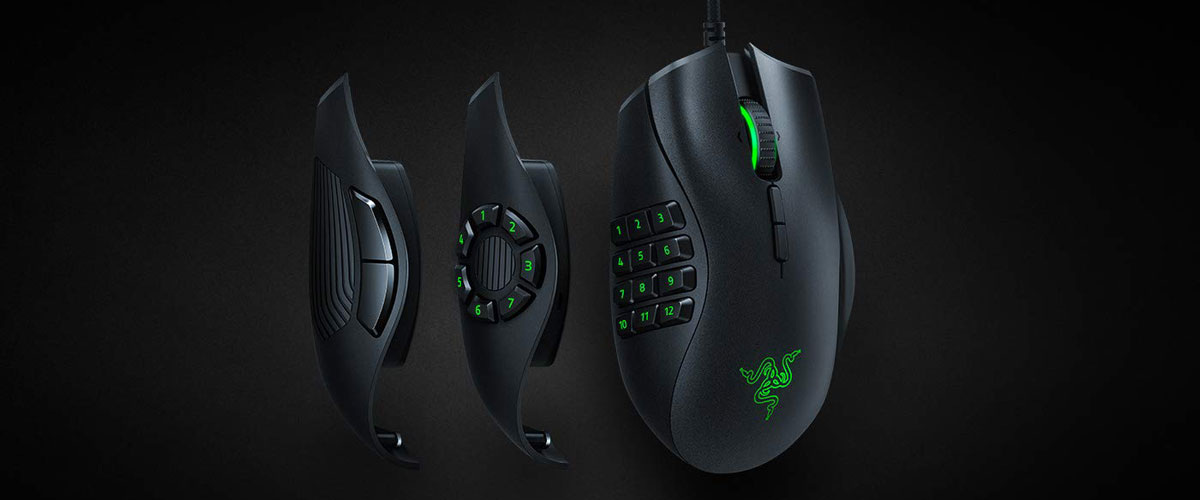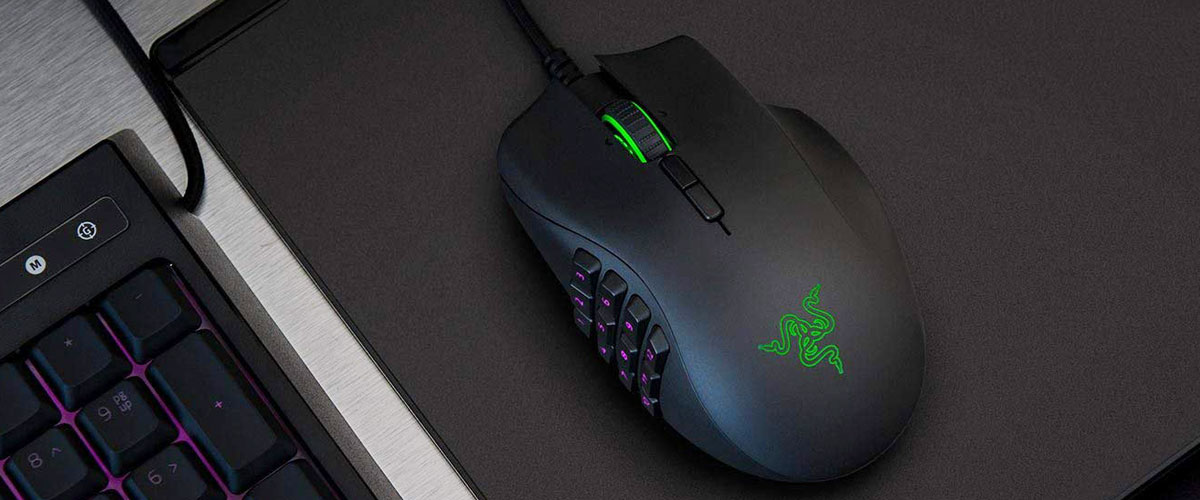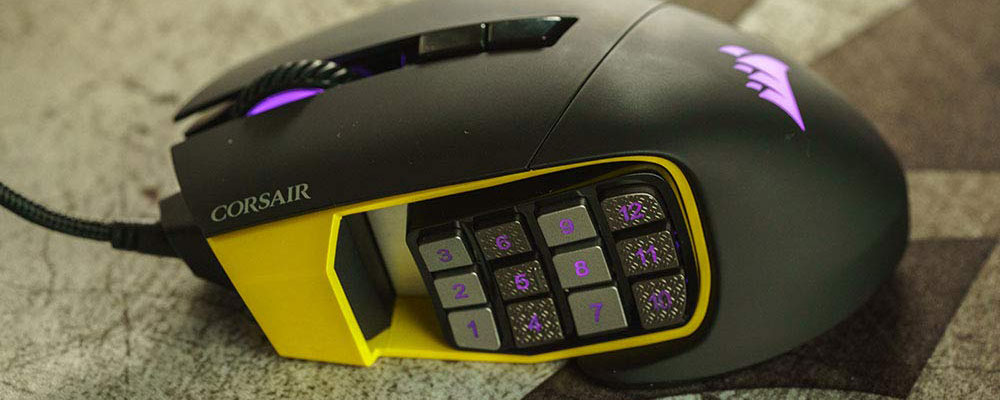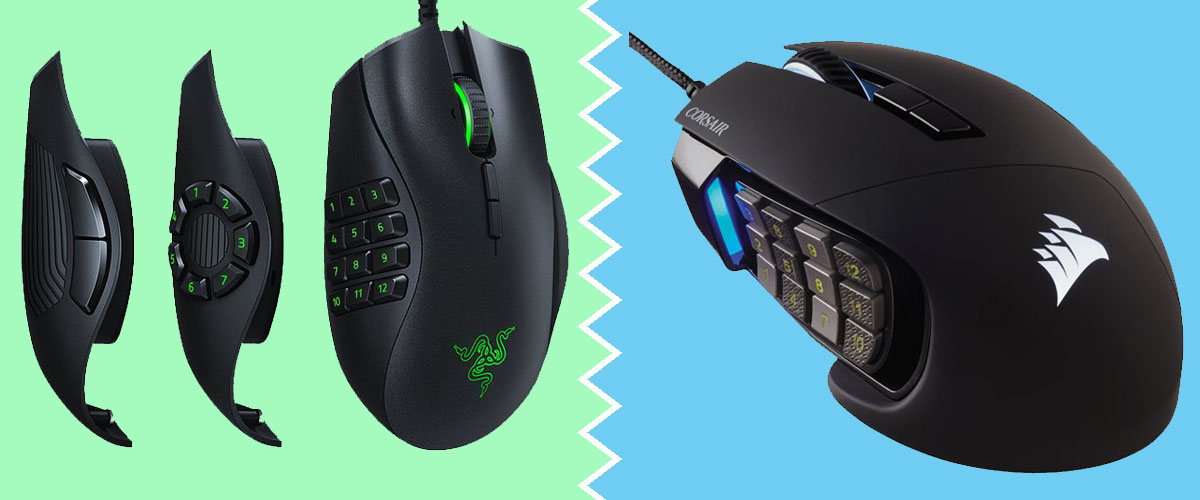On this page, I’ll be comparing the Razer Naga Trinity vs the Corsair Scimitar Pro. Two mice which are similar at first glance, but each having their own unique features. Both of these mice are aimed at MMORPG players, and maybe some MOBA players too. What makes a mouse designed for MMO gameplay is the extra buttons. There are not many games that require 12+ side buttons outside of MMO games such as World of Warcraft.
Razer Naga Trinity
- DPI: 16,000
- Sensor type: Optical
- Side buttons: 2 / 7 / 12
- Weight: 120g
- Cable: Braided 2.1m long
- Lighting: RGB
- Dimensions: 119mm x 74mm x 43mm
Corsair Scimitar Pro
- DPI: 16,000
- Sensor type: Optical
- Side buttons: 12
- Weight: 140g
- Cable: Braided 1.8m long
- Lighting: RGB
- Dimensions: 119.4mm x 77mm x 42.4mm
Key features: Razer Naga Trinity
Interchangeable side panels
Razer may not be the first to include a feature like this, but they have done it better all competitors. The mouse comes with three side panels, one with 2 buttons, one with 7 and lastly one with 12. This for me is the highlight of this mouse, although I mostly play MMOs, I don’t always want or need 12 buttons on the side. You are free to switch between these panels to fit your needs. For example, 12 buttons would be great for World of Warcraft, but for an FPS game like CSGO you might prefer to have 2 buttons.
All of the side buttons have award-winning Razer mechanical switches. The side buttons on my old Razer Naga Molten are still working perfectly after years of use, the buttons on the Trinity should last just as long if not longer.

Designed for comfort
The way the Naga Trinity is designed makes it suitable for all genres of PC games, but you can tell it’s primarily targeted at MMO players. The mouse has an ergonomic shape for right-hand use. The shape is comfortable and perfect for long gaming sessions. It’s on the heavy side weighing 120g, which is common for MMO mice as they prioritize comfort over being lightweight.

16,000 DPI 5G optical sensor
The sensor on the mouse is a high-quality optical sensor offering up to 16,000 DPI. Razer mice sensors have a great reputation, and considering this mouse is mainly aimed for MMO games I can guarantee the sensor will outperform its needs. The DPI is adjustable in intervals of 50 which is done on the Razer Synapse program. You can also adjust the DPI on the fly with the two buttons below the scroll wheel.
Razer Synapse software
Like all Razer products, you can adjust and customize everything on using the Razer Synapse software. All of the buttons on the mouse are programmable in the software. This is also where you can customize the RGB colors, Razer claims there are 16.8 million color options but I haven’t counted them myself. Your profiles are stored on the mouse itself or in cloud storage
Key featurers: Corsair Scimitar Pro
12 mechanical side buttons
The Corsair Scimitar Pro has 12 side buttons, which seems to be the standard for MMO mice nowadays. All 12 of the buttons are mechanical and designed to pro player specifications. The buttons are textured in a way to improve the grip and feel. This should also help you get familiar with them quicker, especially if you’re new to using this many side buttons.
Key slider panel
The main feature of this mouse is definitely the key slider system. The 12 side buttons are on a panel that can be moved and locked in place. The position of the panel is adjustable up to 8mm. This allows you to place the buttons exactly where you want them, keeping up with the theme of comfort and adjustability that MMO mice tend to have. The interesting thing about this feature is that it’s exclusive to Corsair mice, you won’t find this style of adjustability elsewhere.

Corsair Utility Engine
The Corsair Utility Engine is what you’ll be using to set up your keybinds and macros. This is also where you can adjust your DPI and RGB lighting. Multiple profiles can be stored on this mouse itself, this way you can simply plug and play on any computer once it’s setup. If you own multiple Corsair products you can download the Corsair iCUE software to sync up the RGB lighting with the rest of your gear.
16,000 DPI optical sensor
The mouse has a high-quality sensor that can be virtually tuned to suit all mouse pads. The DPI goes as high as 16,000 and can be adjusted in 1 point intervals. The sensor performs excellently across all game genres. Like most high-end mice the DPI is adjustable by pressing the two buttons below the scroll wheel, you can set the DPI profiles on the Utility Engine software.
Comfortable design
The mouse is medium-sized with a rounder shape than usual. It’s comfortable to use with a palm grip which is nice for long sessions. It weighs around 120g making it almost identical to the Razer Naga Trinity. 120g is on the heavier side for a gaming mouse, but this is common with mice designed for MMO gameplay.
Reviewing the reviews: Razer Naga Trinity
Positive
The reviews for the Razer mouse are overall positive. A lot of the reviewers had been using older versions of the Razer Naga and say this is a nice upgrade. The changeable side plates are a huge success, people love having the option to change button layouts depending on what game they’re currently playing.
Negative
A lot of the negative comments about the mouse were to do with the weight. Heavy mice are not ideal for FPS games as it’s common to lift the mouse while playing due to low sensitivity, which is much easier on a lightweight mouse. Another complaint was that you cannot import profiles from old Razer software into the new software that comes with the Naga Trinity.
Reviewing the reviews: Corsair Scimitar Pro
Positive
I noticed a few reviews praising the side buttons key slider, people with smaller hands said they were able to reach all 12 buttons after adjusting the position of the side panel. The shape and size of the mouse received a positive response, although this heavily depends on hand size. One Amazon reviewer said the side buttons are very responsive and satisfying.
Negative
A recurring complaint was the experience using Corsair iCUE software which is used to customize the mouse settings. Many people were frustrated with the software, reporting multiple issues trying to set up the mouse. It’s worrying to see so many people struggle to use the Corsair software that’s necessary to customize a lot of the mouse options.
Conclusion
These two mice are extremely similar, which you prefer will come down to the design, shape and side button options and layout. You also have to consider the price, as of writing this the Corsair mouse is significantly cheaper.
Design
Which design you prefer will come down to personal preference. The Corsair mouse comes in two color schemes, yellow and black. Whereas the Razer mouse is only available in one color. I personally prefer the look of the Corsair mouse, but maybe I’m just bored of the Razer Naga style as I’ve owned one for a few years.
Shape and feel
These mice are an extremely similar shape, but there are some noticeable differences. The left and right-click buttons on the Razer mouse are slightly curved for comfort, which is not the case for the Corsair mouse. Both mice have a place for your ring finger to rest, but the Corsair mouse has rubber grip texture there which the Razer mouse does not. The shell of the Corsair mouse is slightly more rubberized than the Razer mouse which has a harder shell.
Side buttons
The interchangeable side panels on the Razer mouse are easily the most impressive feature. If you are someone who frequently switches between games and would enjoy using different button layouts, this alone could be enough to go for the Naga Trinity.
Unlike the Razer mouse, a few of the side buttons on the Corsair Scimitar Pro are textured. The texture will improve your grip on the mouse, as well as help you get familiar with the layout. The key slider side panel is exclusive to the Scimitar Pro and won’t be found on any Razer mouse.

